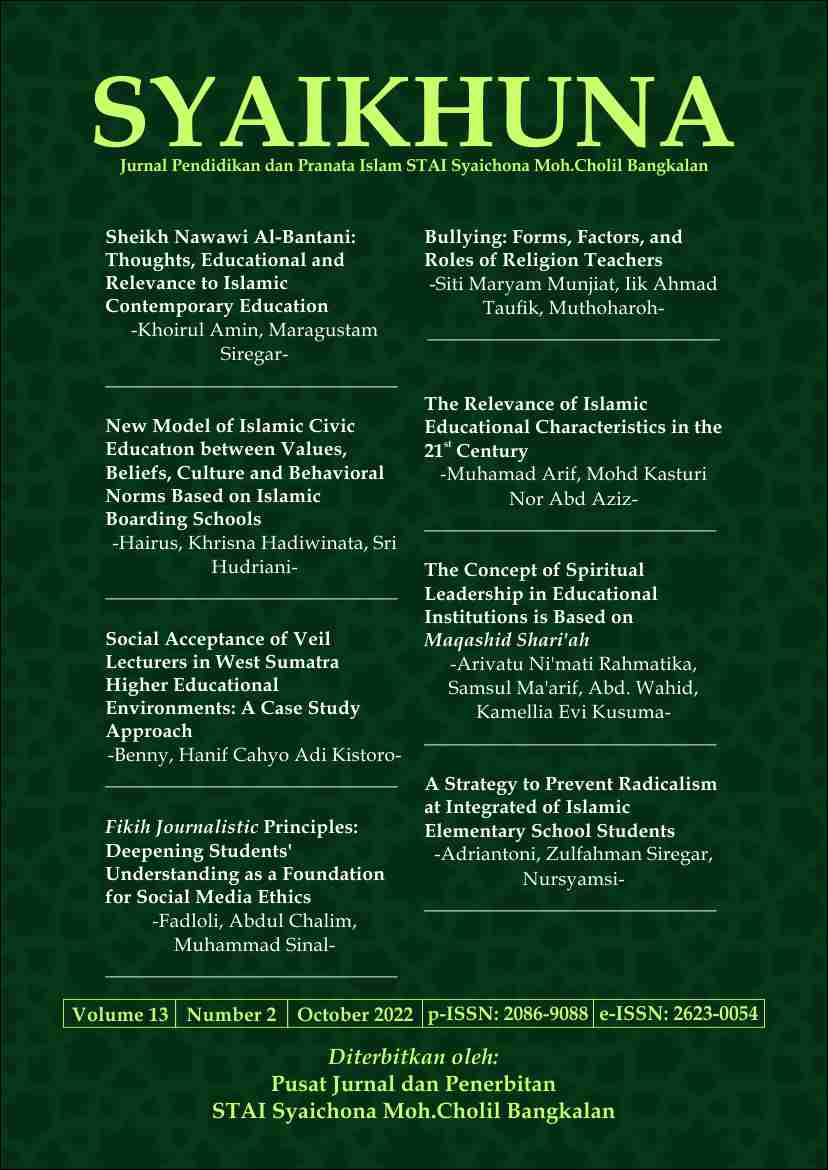Bullying: Forms, Factors, and Roles of Religion Teachers
(Case Study of Student SMAN 1 Astanajapura Kabupaten Cirebon)
DOI:
https://doi.org/10.36835/syaikhuna.v13i02.5947Keywords:
Teacher Role, Islamic Education, BullyingAbstract
Bullying is one of the issues that persist today and has yet to be resolved because it is seen as a natural occurrence, even though it has both short- and long-term consequences for victims, offenders, and those who watch it. As a result, the purpose of this research is to identify the types of bullying that exist in SMAN 1 Astanajapura, Cirebon Regency, as well as the role of Religion Teachers in dealing with bullying in SMAN 1 Astanajapura, Cirebon Regency. At SMAN 1 Astanajapura, Cirebon Regency, and understanding the variables that lead to bullying. This sort of study combines qualitative and descriptive research methods. Observation, interviews, documentation using data reduction analysis, data presentation, and verification are all used in the data collection approach. The findings revealed that the most common form of bullying in SMAN 1 Astanajapura were verbal bullying, which included providing nicknames, mocking, and disparaging others' physical or mental flaws. Hitting, pinching, grabbing, and harassing are examples of physical bullying. Psychological bullying, such as ostracism, and media bullying, such as mocking on social media or in online games. Second, PAI teachers' role in dealing with bullying is divided into two stages: prevention and follow-up, which includes things like conducting supervision, socializing and extracurricular activities, guidance, teaching education and exemplary behaviour, and coordinating with all school members. Parents, friends, and social media were all contributors to the bullying that occurred at SMAN 1 Astanajapura.References
Amanda, G. (2021). Stop Bullying. Cemerlang Publishing.
N, Anggraini. (2021), Peran Guru Dalam Mengatasi Perilaku Bullying Pada Peserta Didik Kelas Iv Sd Negeri Banding Kecamatan Rajabasa Kabupaten Lampung Selatan, Fakultas Tarbiyah Dan Ilmu Keguruan Universitas Islam Negeri Raden Intan :Lampung.
Djamarah, S. B. (2014). Guru dan Anak Didik Dalam Interaksi Edukatif. Rineka Cipta.
Elly Setiadi, U. K. (2015). Pengantar Sosiologi Pemahaman Fakta dan Gejala Permasalahan Sosial:Teori, Aplikasi, dan Pemecahannya. Kencana Prenada Media Group.
Fatma Utami, N. B. (2018). Pengaruh Media Sosial Terhadap Perilaku Cyber Bullying Pada Kalangan Remaja. Humaniora Bina Sarana Informatika, 18(2), 257. http://ejournal.bsi.ac.id/ejurnal/index.php/cakrawala
Hidayati, A. S. (2019). Analisis Faktor-faktor Penyebab Bullying di Kalangan Peserta Didik Era Milenial. Skripsi S1 UNIVERSITAS MUHAMMADIYAH SURAKARTA, 3, 6.
Irayani, N. L. D. (2021). Hubungan Pola Asuh dan Pola Komunikasi Keluarga Terhadap Perilaku Bullying Anak Sekolah Di SMP Negeri 2 Abang - Bina Usada Repository. 81. http://repository.binausadabali.ac.id/398/
Khasanah, U. (2020). Peran Guru Pendidikan Agama Islam Dalam Membentuk Karakter Disiplin Siswa Kelas VIII Di MTS Darul Hikam Kota Cirebon. Skripsi S1 IAIN Syekh Nurjati Cirebon, 15.
Musbikin, I. (2012). Mengatasi Anak Mogok Sekolah + Malas Belajar. Laksana.
Mulyasa, E. (2013). Menjadi Guru Profesional: Menciptakan Pembelajaran Kreatif dan Menyenangkan. PT. Remaja Rosdakarya.
Novi Poespita, C. (2016). Sekolah Nir Kekerasan. Ifada Press.
OECD. (2018). Organisation for Economic Co-operation and Development. Programme for International Student Assessment, 7. https://www.oecd.org/pisa/pisa-2015-results-in-focus.pdf
Pangestu, S. (2021). Analisis Mengenai Dampak Verbal Bullying Terhadap Kecerdasan Interpersonal Sswa Kelas V SD Negeri Margajaya II Kota Bekasi. Skripsi S1 Fakultas Ilmu Pendidikan Universitas Muhammadiyah Jakarta, 74.
Maria, N. (2017). Pengaruh pola asuh dan bullying terhadap harga diri pada anak kelompok B TK di Kota Pekanbaru Tahun 2016 (The effect of parenting and bullying on self-esteem in children grade B kindergarten in Pekanbaru city at 2016). Educhild, 6(1), 62.
Mulyasa, E. (2013). Menjadi Guru Profesional: Menciptakan Pembelajaran Kreatif dan Menyenangkan. PT. Remaja Rosdakarya.
Priyatna, A. (2010). Let’s End Bullying : Memahami, Mencegah, dan Mengatasi Bulying. PT Elex Media Kumputindo.
Purwanto, N. (2011). Ilmu Pendidikan Teoritis dan Praktis. PT. Remaja Rosdakarya.
ROBO, L. (2021). Peran Guru Pendidikan Agama Islam (PAI) Dalam Membina Akhlak Peserta Didik SMA Negeri 2 Buru Selatan Kelas X Kec. Ambalau Kabupaten Buru Selatan. Industry and Higher Education, 3(1), 28–29. http://journal.unilak.ac.id/index.php/JIEB/article/view/3845%0Ahttp://dspace.uc.ac.id/handle/123456789/1288
Rosyada, D. (2020). Penelitian Kualitatif Untuk Ilmu Pendidikan. Kencana.
Rukajat, A. (2018). Pendekatan Penelitian Kualitatif. Deepublish.
Rusmini. (2017). Metode penelitian: Teori dan Aplikasi Penelitian Kualitatif, Kuantitatif, Mixed Methods, serta Research & Development. Pusaka Jambi.
Wiyani, N. A. (2017). Save Our Children From School Bullying. Ar-Ruz Media.
Sugiyono. (2021). Metode Penelitian Kuantitatif, kualitatif, dan R&D. Alfabeta.
Yunita Bulu, Maemunah, S. (2019). Faktor-faktor yang Mempengaruhi Perilaku Bullying pada Remaja Awal. Nursing News, 4(1), 58. https://publikasi.unitri.ac.id/index.php/fikes/article/download/1473/1047
Downloads
Published
How to Cite
Issue
Section
License
Copyright (c) 2022 Siti Maryam Munjiat, Iik Ahmad Taufik, Muthoharoh Muthoharoh

This work is licensed under a Creative Commons Attribution 4.0 International License.





